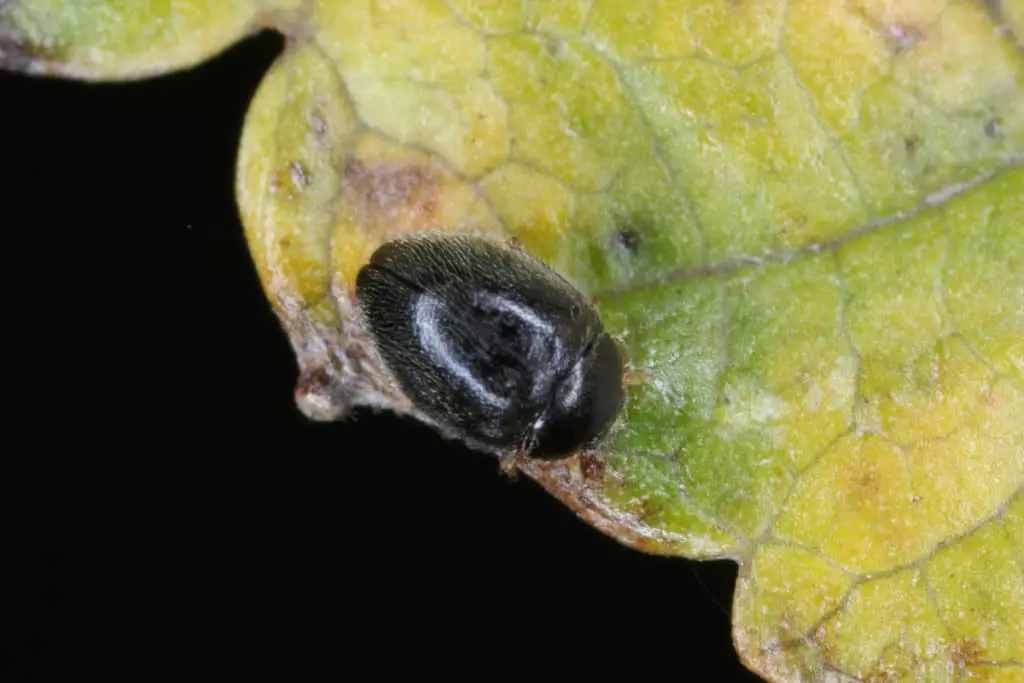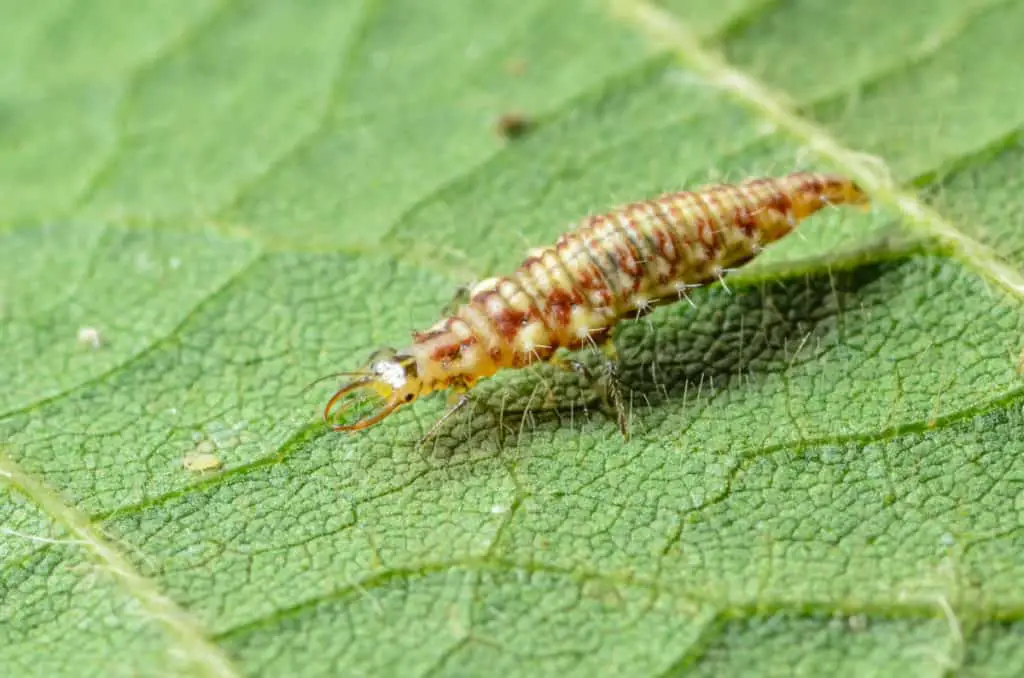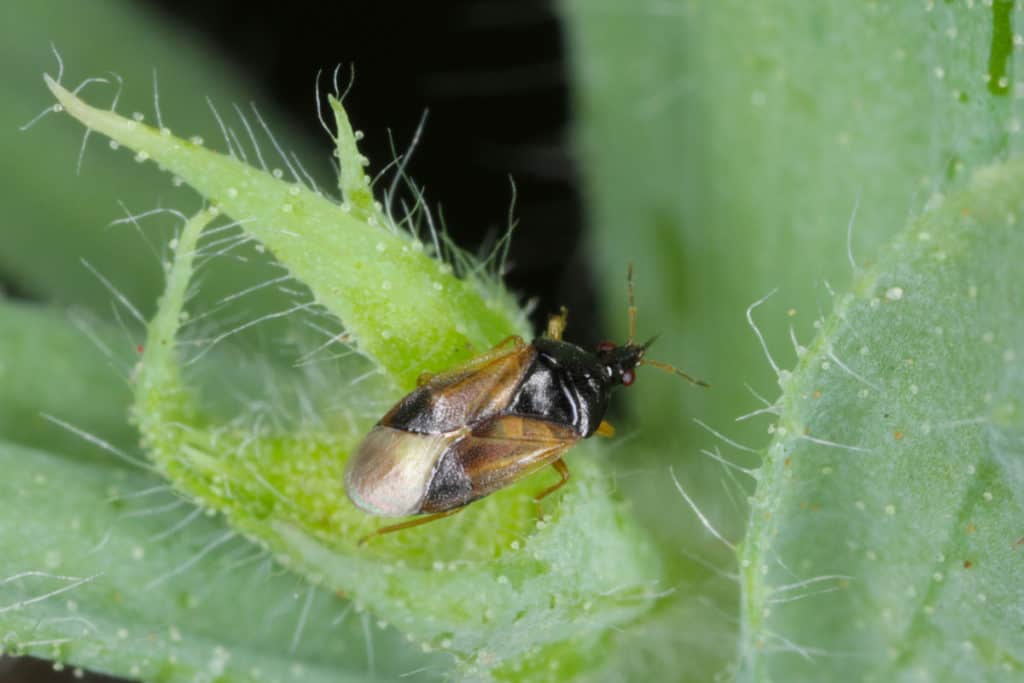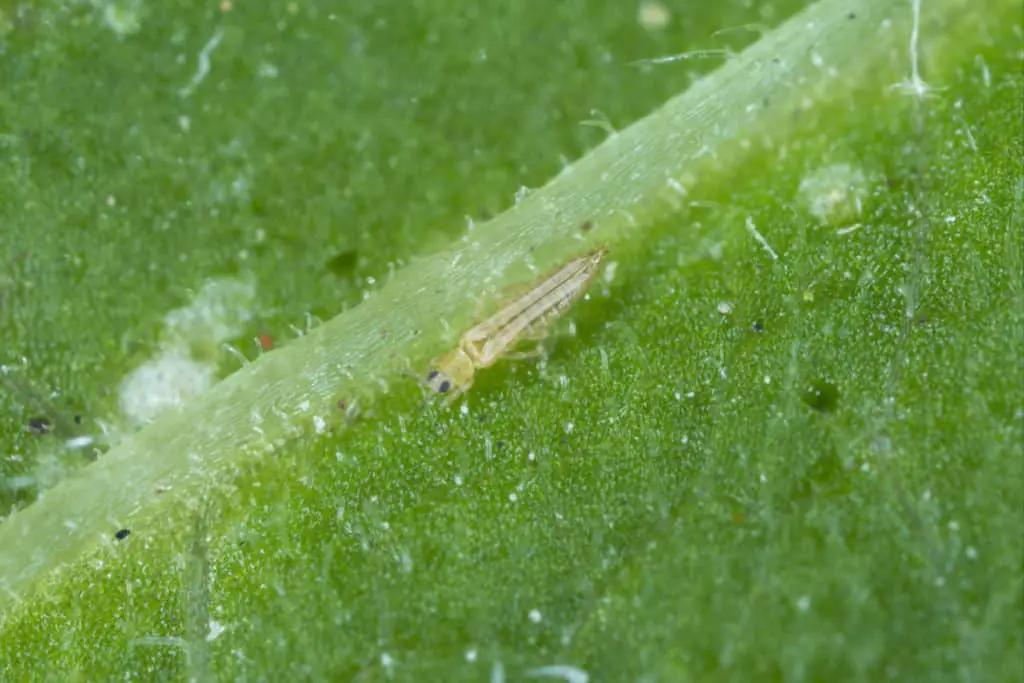There are several natural predators of spider mites. It is important to know the best conditions to help these predators thrive in order to keep the spider mite population low to none existent.
So, what eats spider mites? Persimilis and Fallacis are predatory mites that eat spider mites. Ladybugs, lacewings, minute pirate bugs, and the western flower thrip also feed on spider mites. These insects and mites can control spider mites in your garden and are used in agriculture to control spider mite infestations.
To learn more about what eats spider mites, read on!
Do You Have Spider Mites?
You may suspect that you have spider mites in your garden because you have seen stippling on your crops. But are they spider mites or clover mites? Both are mites that feed on plants and leave stippling damage.

However, spider mites form webbing on the plants they attack and they leave accumulated exoskeleton and feces. The webbing is the most reliable sign of a spider mite infestation because no other mite species creates a web.
While it is impossible to see spider mites with your naked eye, telltale signs on the plant can announce their presence. In addition to the web, look out for the following:
- White-spotted small injuries on the leaves
- The leaves turn yellow, brown, or black
- Stunted growth
An easy experiment to do is to hold a white sheet of paper next to your plant and give the leaves a shake. If small black specks that resemble black pepper fall onto the paper, then you have a spider mite infestation.
What Eats Spider Mites?
The list below features the insects and organisms that eat spider mites with the most prolific feeders at the top.
- Persimilis
- Fallacis
- Ladybugs
- Lacewings
- Minute Pirate Bug
- Western Flower Thrip
1. Persimilis
The Phytoseiulus persimilis is a predatory mite that favors spider mite species like two-spotted spider mites. These predatory mites are voracious eaters that cannot go for long without eating so when introduced into a spider mite population they go through it fast and effectively. They are entirely dependent on the mites for food. Release two per square feet to effectively tackle the spider mite population.
Persimilis are tiny measuring only 0.5 mm. The female lays her eggs, which can be up to 60, within the spider mite population. The larvae from their eggs begin to feed on the spider mite population eggs, larvae, and adults. Persimilis multiply at twice the rate of their prey.
The life span of the predatory mites is about 45 days from egg to adulthood. They spend eight days from hatching to becoming larvae and nymphs before the next 36 days as adults. Their eggs are twice the size of the spider mite eggs. Maintaining a conducive environment of 60 to 90 degrees Fahrenheit is crucial to the development and optimal performance of persimilis. These mites do not do well in cold environments so they need a relative humidity of 60% or above.
Persimilis are very active and also very mobile. They quickly move from one plant to another and within a few days, the entire crop will have a presence. These predator mites are orange to red in color and have a pear shape. When immature they are transparent. They perform extremely well on all crops except for tomatoes. That is because the tomato plant is densely packed with sticky glandular hairs that are also poisonous and that prevent the mites from effectively adapting to the environment.
The adult persimilis feeds on up to 20 young spider mites per day or 7 adults.
Pro Tip
Persimilis are excellent predatory mites for two-spotted spider mites and bean spider mites.
2. Fallacis
This predatory mite eats all spider mites indiscriminately making it the most effective solution of spider mites. Their scientific name is Neoseiulus Fallacis. Releasing one to two mites per square meter will achieve spider mite control for a couple of years on long-term crops.
The good news is that when spider mite supply is low, these predatory mites will feed on wind-blown pollen while staying in one place. That means they do not migrate in search of food but the winter reduces their number as food becomes scarce. However, when the spider mites are back in season, the Fallacis resume feeding on them and they reproduce rapidly to become numerous within a short period of time.
They lay up to 60 eggs and their life cycle from egg to adulthood is about 20 days. Because of their numerous eggs and quick maturity, they easily overtake their prey’s population. Generally, Fallacis take a third of the time it takes other mites to mature. They thrive in temperatures above 64 degrees Fahrenheit with a humidity of 50% or more.
These mites are also pear-shaped like the Persimilis but they are usually white in color. However, after feeding they take on the color of their prey which is usually red to orange-brown. Fallacis are excellent predator mites to introduce to the tomato and other vegetable crops because they are resilient.
The female Fallacis eats up to 16 spider mites per day.
Pro Tip
Introduce them in a crop in the summer feeding to feed on the spider mites and they will overwinter with the pests.
Predatory mites are very effective against spider mites making them the premier most preferred method of dealing with spider mites.
3. Ladybugs
To be more specific, the stethorus also known as the Stethorus punctillum is a lady beetle that specifically feeds on spider mites namely
- Two-spotted spider mites
- Southern red spider mites
- Spruce spider mites
- European spider mites

They are small in size measuring only 1.5 mm when full-grown adults. Stethorus has an oval shape with dark brown to black coloring and yellowish-brown mouthparts, antennae, and legs. The adults can fly allowing them to move from plant to plant during feeding. Regularly releasing these ladybugs is recommended with 3-4 insects per 10 square feet being an effective number.
This ladybug species is proficient at finding even the smallest population of spider mites. Their females lay 3-13 eggs daily which completes their lifecycle in 20 days. Since the ladybugs have a life span of up to 2 years allowing the female to lay thousands of eggs to sustain the beetle population.
Both the larvae of the beetle and the adult feed on the spider mites. The adult can feed on over 50 spider mites eggs in a day and 10 adults. The females eat even more spider mites, 20 to 40, to sustain egg lay.
The Stethorus can live side by side with predatory spider mites like Persimilis and Fallacis above, for a sustained attack on the spider mites. And they continue to survive on the plants for a long time because they also eat aphids, nectar, and pollen when the spider mite supply is low.
If you are interested in knowing more about what ladybugs feed of then check out this article we have written, What Do Ladybugs Eat?
Pro Tip
Use controlled amounts of fenbutatin oxide together with stethorus when dealing with hotspots. This pesticide does not harm stethorus.
4. Lacewings
Green lacewings are an effective control against spider mites. They control the spider mite population throughout the growing season when these mites are most active. The larvae are the predators of spider mites because they feed on soft-bodied organisms to sustain growth and development. However, the adults only feed on pollen, honeydew, and nectar. The green lacewing larvae favor the red spider mites.

The lacewing eggs hatch into larvae that roam the plant looking for food. They sustain their feeding spree for up to three weeks and then enter a cocoon where they develop into adulthood within 14 days. The fact that lacewings can tolerate a wide range of temperatures means that they sustain spider mite control through all seasons.
Releasing 10 eggs or larvae per plant is effective. The larvae are typically gray in color and look like an alligator that has pincers. They kill the spider mites by injecting them with their paralyzing venom and then proceed to draw out the fluid from the mite. These larvae love warm weather but do not release them during the heat of the day.
When newly hatched, lacewing larvae are voraciously hungry and they can cannibalize each other if they don’t find a consistent food source. One larva can consume up to 200 spider mites per week indiscriminately eating the eggs, larvae, and adults of the mites.
Pro Tip
When you have a severe spider mite infestation, consider investing in the green lacewing larvae instead of the adult. As soon as they are introduced into the crop, they begin feeding on spider mites. This is quicker than getting adults and waiting for them to hatch eggs that become larvae.
5. Minute Pirate Bug
Also known as the Orius insidious, this insect has a preference for spider mites, thrips, and aphids. They also feed on the spider mite by injecting their beaks into the mites and sucking out their juices. Release up to 2000 Orius into an acre for effective spider mite control.

The bug feeds on the mite’s eggs, larvae and adults. They can eat up to 30 spider mites a day. The minute pirate bug is also referred to as the flower bug and they are tiny in size measuring only 1/16th of an inch. They have an oval-shaped body that is black to purplish with white patches on the wings.
The adults can fly around which enables them to feed earnestly on colonies of spider mites.
Pro Tip
If you have an infestation of thrips as well, this is a beneficial predator that also attacks thrips. In fact, it is one of the few insects that eat adult thrips.
6. Western Flower Thrips
Not all thrips have an appetite for spider mites. But the Western flower thrips love to eat spider mites. These thrips are omnivorous meaning they eat both insect, arthropod, and plant life. Because of that, they are a threat to mites in two ways: they feed on the mites and also compete with the mites for plant food.

The larvae of the thrips attack the eggs of the two-spotted spider mites but unfortunately, they also attack the eggs of predatory mites that control the spider mite population. The western flower thrip is also known as Frankliniella occidentalis.
Pro Tip
While Western flower thrips eat spider mites they are not the ideal solution to controlling the mites population. After they have finished eating their prey, they will turn on the crop and become pests. That makes them a potential threat that is just waiting to happen even though they are excellent at destroying spider mites.
Options For Getting Rid Of Spider Mites
There are several options available for getting rid of spider mites. They include
- Insecticidal soap
- Toxic, short-lived chemical insecticide
- An organic insecticide that features food-grade ingredients like diatomaceous earth
- A biological insecticide that contains an entomopathogenic fungus
- Essential oils like pure neem oil
- Horticultural oil to kill overwintering eggs
However, of all the options available, the best solution is a natural one where you introduce organisms that eat the spider mites. This is a long-term, sustainable and safe method that leaves your crops intact while decimating spider mite populations.
How Do Commercial Farmers Control Spider Mites Naturally?
You can introduce predatory mites into large-scale farms using the Controlled Release System (CRS sachets). How do CRS sachets work?
The mites are placed into the sachets which are strategically placed all over the farm. The sachets are opened allowing the mites to get out and onto the nearest plants where they find their prey. These breeding sachets are produced by companies like Bioline and they come in various sizes.
Bioline CRS Package Sizes
The Mini Sachet
This is a small sachet that works if you are dealing with the beginnings of a spider mite infestation. It offers an easy application and you have more release points on the farm.
The Gemini Sachet
This sachet is ideal if you want to release the mites into a farm that features an overhead irrigation system. It is waterproof keeping the mites safe from drowning and it delivers more mites in areas under wet conditions.
The Bugline Sachet
With this option, you avoid the overhead water completely while maintaining a dry distribution platform for the mites. They are completely uninhibited by the automatic watering processes of your farm.
Mini Sachet On A Stick
This option offers you the easy establishment of the mini sachet while also being elevated and waterproof so it does not come close to the water. The mites can be released close to the wet soil but not within the water. It also offers users a 2-week lead time.
These breeding sachets produce the predatory mites for four to eight weeks from the time they are opened. The sachets offer you higher levels of predatory mites allowing you to enjoy a higher success rate with this method of biological spider mite control.
The Wrap Up
For spider mite predators to thrive they need you to offer them a habitat without insecticides and pesticides that kill them. So make sure you do not spray the farm with chemical insecticide at least for a week or so before introducing the spider mite predators.
Also, make sure the temperature and humidity levels are conducive for growth. And finally, make sure that there is foliage for the predatory mites and pollen in the vicinity for the stethorus and lacewings. As long as there is food, these insects and organisms will be content to stay on your farm and do what they do best: control the spider mite population you are grappling with.
If you are interested we do have some more articles about spider mites:
Clover Mites Vs Spider Mites: What is the Difference?
Sources
https://www.gardeningknowhow.com/plant-problems/pests/insects/spider-mite-treatment.htm
https://www.thebuglady.ca/spider-mite-control
planetnatural.com/pest-problem-solver/houseplant-pests/spider-mite-control/
https://greenmethods.com/persimilis/
https://www.sciencedirect.com/topics/agricultural-and-biological-sciences/stethorus
https://gpnmag.com/article/effective-release-methods-of-predatory-mites/
https://link.springer.com/article/10.1023/B:APPA.0000018885.35044.c6
https://biocontrol.entomology.cornell.edu/predators/Neoseiulus.php
https://www.gardeninsects.com/greenlacewings.asp
https://extension.umd.edu/hgic/topics/predators-minute-pirate-bugs
